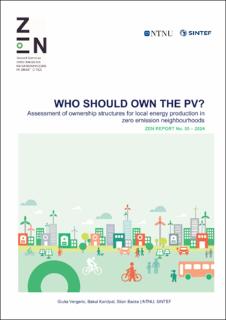| dc.description.abstract | Ownership structures for local energy production in zero emission neighbourhoods
Nyhavna, an industrial area in Trondheim, Norway, is undergoing a transformation into a zero-emission neighbourhood (ZEN) as an extension of the city centre. This initiative, decided in 2019 by Trondheim Kommune, involves approximately 300,000 m2 of new and 40,000 m2 of preserved buildings, focusing on residential structures alongside commercial spaces.
A key strategy to realize ZEN involves locally producing electricity through solar photovoltaic panels on building surfaces. However, challenges include determining a sustainable ownership structure for photovoltaic installations and understanding how it impacts the planning process for Nyhavna's development. In this report, we qualitatively and quantitatively assess different ownership configurations and their impact on the operational and use phases of the neighbourhood.
Based on a stakeholder mapping, we identify several ownership configurations. Various stakeholders within the energy network could potentially assume the role of solar photovoltaic owners, including users, electricity suppliers (both new and existing companies), third-party entities (such as service and asset providers), and the district heating company.
Each ownership configuration has both benefits and drawbacks. For maximized economic value, the owner of the photovoltaics should also be the consumer of the photovoltaics, which will be the case for users or the district heating company. In the case of ownership by electricity suppliers and third-party entities, there is a need to negotiate prices and contracts with the electricity consumers.
In any case, oversizing photovoltaic systems poses some economic risks, which emphasizes the need for strategic sizing based on specific needs and consumption profiles to maximize profitability. Simultaneously, Nyhavna needs a large amount of photovoltaics to reach ZEN goals.
The results in this report provide a comprehensive understanding of the factors influencing the decision-making process for solar PV ownership in a zero-emission neighborhood, offering examples and practical guidance for stakeholders involved in the planning, development, and operation of such initiatives. The requirements set by the project owners and developers, as well as designers, will influence any ownership structure, while the economic incentives for aligning flexible assets towards local electricity production will vary across ownerships.
The decision on photovoltaic ownership during Nyhavna's operational phase is just one aspect of a broader transformative initiative. To uphold ZEN goals, it is crucial to link decisions impacting photovoltaics and their future owners to the initial initiative and planning stages where Nyhavna currently stands. | en_US |
